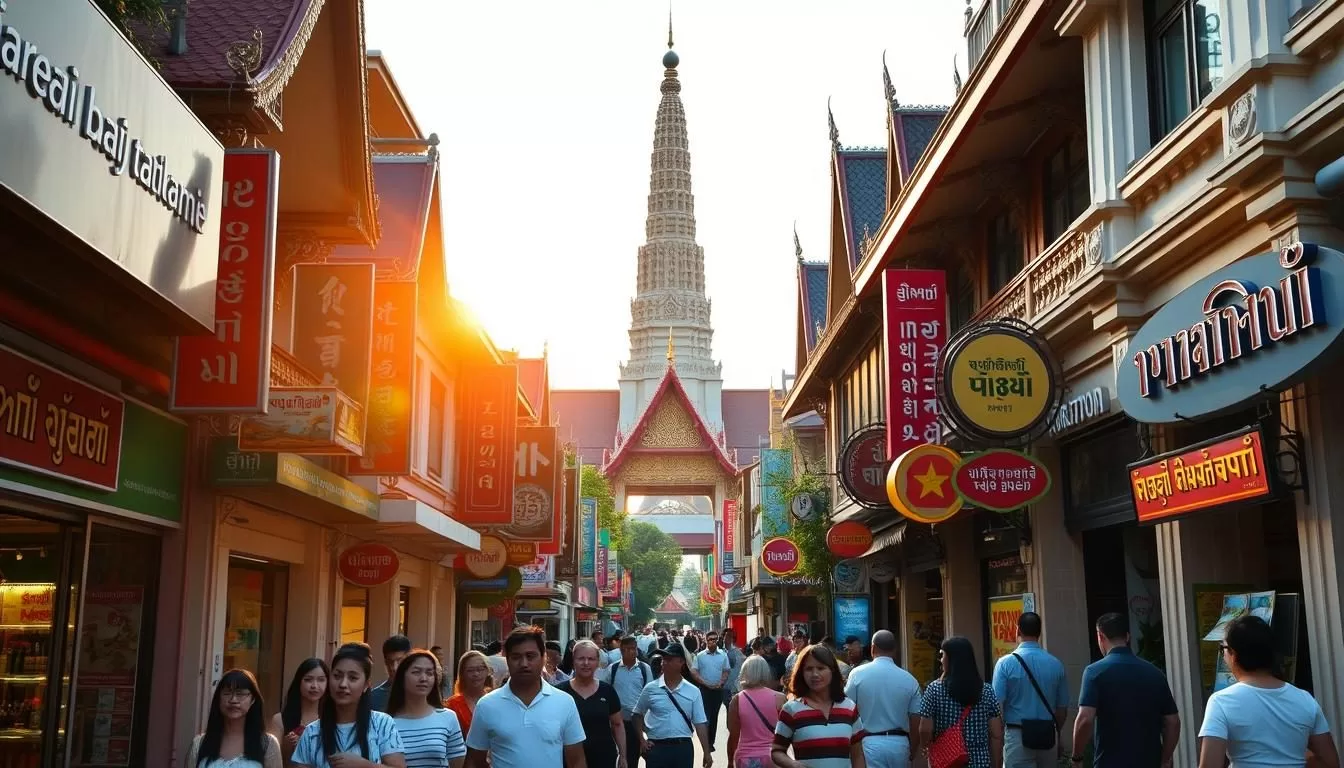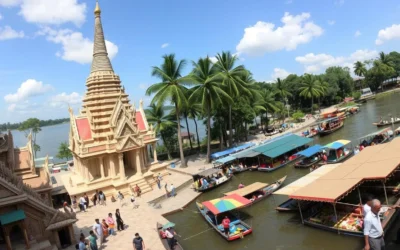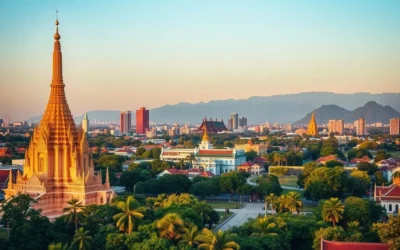When you think of Thailand, its vibrant culture and stunning landscapes often come to mind. But did you know that its linguistic landscape is just as fascinating? The Thai language, specifically Central Thai, is the backbone of communication here. It’s spoken by nearly 97% of the population, making it the dominant language in government, education, and media.
Beyond Central Thai, the country boasts a rich diversity of dialects and minority languages. For instance, Isan, Northern Thai, and Southern Thai are widely used in their respective regions. This linguistic variety reflects Thailand’s cultural depth and regional identities.
Understanding the language scene here gives you a deeper appreciation of its people and traditions. Whether you’re navigating bustling cities or serene villages, the Thai language connects you to the heart of this beautiful country.
Overview of Thailand’s Linguistic Landscape
Exploring the linguistic landscape reveals a fascinating blend of dialects and scripts. The Thai script is one of the most unique writing systems in the world, with 44 consonants and 32 vowels. This complexity adds depth to the language, making it both challenging and rewarding to learn.
One of the most distinctive features is its tonal nature. With five distinct tones, the meaning of a word can change entirely based on pronunciation. For example, the word “mai” can mean “new,” “wood,” or “not” depending on the tone used. This tonal system is a key aspect of daily communication.
Dialects vary significantly across regions. In the north, you’ll hear Northern Thai, while Southern Thai dominates the south. Each dialect carries its own cultural identity, reflecting the diversity of the people. These regional differences enrich the linguistic tapestry of the country.
“Language is the road map of a culture. It tells you where its people come from and where they are going.”
Understanding the script and tones is essential for mastering the language. Vowels and consonants combine in intricate ways, creating a rhythmic flow in speech. Whether you’re in bustling cities or quiet villages, the language connects you to the heart of the culture.
Historical Background of Thai Language
Tracing the roots of the Thai language reveals a rich tapestry of history. Its evolution from Old Thai to Modern Thai is marked by significant shifts in consonant usage and tone systems. For example, the Sukothai Inscription, dating back to 1292, is one of the earliest records of the written language.

Over the centuries, the language has absorbed vocabulary and grammar from Sanskrit, Pali, and Khmer. These influences enriched its structure and added depth to its expressions. For instance, many religious and philosophical terms in Thai originate from Sanskrit.
One of the most notable changes is the development of the Thai script in 1283 under King Ramamhaeng the Great. This script, with its 44 consonants and 16 vowels, became the foundation of written communication.
“Language is the mirror of history, reflecting the journey of a people.”
The tonal system also evolved, with Old Thai having fewer tones than Modern Thai. This shift made the language more nuanced and expressive. Understanding these changes helps you appreciate how historical developments continue to shape modern Thai.
Central Thai: The Official Language of Thailand
Central Thai stands as the cornerstone of communication in the country. It’s the primary language used in education, governance, and media. Nearly 97% of the population speaks it, making it the most widely understood form of Thai.
This language plays a vital role at every level of society. From classrooms to government offices, Central Thai is the standard. It’s also the preferred choice for national broadcasts and official documents.
The number of speakers is impressive. As of 2024, there are approximately 71 million Central Thai speakers, including 27 million native speakers and 44 million second-language learners. This widespread use ensures it remains the dominant language across the country.
Government policies actively support its standardization. Schools teach Central Thai, and it’s the medium of instruction nationwide. This ensures that even those who speak regional dialects are fluent in it.
Here’s a breakdown of language groups and their usage:
| Language Group | Number of Speakers | Primary Use |
|---|---|---|
| Central Thai | 71 million | Education, Governance |
| Isaan (Northeastern Thai) | 20 million | Regional Communication |
| Northern Thai | 6 million | Cultural Identity |
| Southern Thai | 4.5 million | Local Interaction |
Central Thai is more than a language; it’s a unifying force. Whether you’re in bustling cities or quiet villages, it connects people across regions. Its importance in daily life cannot be overstated.
Regional Dialects and Topolects in Thailand
Regional dialects in this country offer a unique glimpse into its cultural depth. From the northeast to the south, each group has its own way of speaking, reflecting centuries of tradition and identity. These dialects are more than just variations in speech—they are a window into the lives of the people who use them.

Isaan (Northeastern Thai) and Its Cultural Significance
The northeastern thai dialect, known as Isaan, is deeply tied to the culture of the region. Spoken by over 20 million people, it shares similarities with Lao, making it a bridge between the two cultures. This dialect is not just a means of communication but a symbol of regional pride.
Isaan’s vocabulary and pronunciation differ from Central Thai, adding to its distinct identity. For example, many words in Isaan are borrowed from Lao, reflecting historical ties. This linguistic connection highlights the shared heritage of the region.
Northern Thai and Southern Thai Variants
In the north, the northern thai dialect, or Kham Mueang, is a testament to the region’s history. Once widely spoken, it has seen a decline in recent years, with many now using Central Thai. Despite this, it remains a vital part of local culture, especially in rural areas.
Down south, the southern thai dialect stands out with its unique vocabulary and intonation. Spoken by around 4.5 million people, it reflects the region’s distinct identity. Whether in bustling markets or quiet villages, this dialect connects people to their roots.
Here’s a breakdown of regional dialects and their population statistics:
| Dialect | Region | Speakers (Millions) |
|---|---|---|
| Isaan | Northeast | 20 |
| Northern Thai | North | 6 |
| Southern Thai | South | 4.5 |
These dialects are more than just ways of speaking—they are a reflection of the group identities that make this country so diverse. Whether you’re exploring the northeast or the south, understanding these variations helps you connect with the people and their stories.
Minority Languages and Ethnolinguistic Diversity in Thailand
Dive into the vibrant world of Thailand’s minority languages, where each word tells a story of cultural resilience. Beyond the dominant Central Thai, the country is home to 51 living indigenous languages. These languages are spoken by various ethnic groups, each contributing to the rich tapestry of the nation’s heritage.
Despite outside pressures, many minority communities have managed to preserve their linguistic traditions. For example, the Thai Isan/Thai Lao population, with 13 million speakers, continues to use their dialect in daily life. Similarly, the Malay Muslim community, numbering 1.5 million, maintains its language as a symbol of identity.
Here’s a breakdown of some key ethnic groups and their languages:
| Ethnic Group | Population | Language |
|---|---|---|
| Thai Isan/Thai Lao | 13 million | Isan |
| Malay Muslim | 1.5 million | Malay |
| Khmer | 1.4 million | Khmer |
| Highland Indigenous | 923,257 | Various Indigenous Languages |
At the community and person level, these languages play a crucial role in daily interactions. They are not just means of communication but also vessels of cultural knowledge and traditions.
“Language is the soul of a culture, carrying the wisdom of generations.”
Understanding and valuing this linguistic diversity enriches your appreciation of Thailand’s cultural heritage. Whether you’re in the highlands or the south, each minority language offers a unique window into the lives of its speakers.
Influence of Neighboring Cultures on Thailand’s Language
Borders have always been bridges for cultural and linguistic exchange in this region. The Thai language is no exception, deeply influenced by interactions with neighboring countries like China and Cambodia. These connections have shaped vocabulary, syntax, and even the way people communicate daily.
One of the most significant influences comes from the Thai Chinese community. Descendants of Chinese migrants brought their dialects, including Teochew, Hokkien, and Cantonese. While many have adopted Standard Thai, traces of these dialects remain in everyday speech.

Along the border regions, cultural exchanges have left a lasting impact. For example, in the northeast, the Isan dialect shares similarities with Lao, reflecting centuries of shared history. This blending of languages enriches the linguistic diversity of the area.
Language families also play a role in shaping Thai. The Mon-Khmer languages, once dominant, have influenced vocabulary and grammar. Today, minority groups like the Lua community continue to preserve these linguistic traditions.
Here’s a breakdown of key influences from neighboring cultures:
| Influence | Region | Impact |
|---|---|---|
| Chinese Dialects | Urban Areas | Vocabulary, Syntax |
| Lao Language | Northeast | Dialect Formation |
| Mon-Khmer | Highlands | Grammar, Vocabulary |
These cross-cultural exchanges have not only shaped the language but also the cultural identity of the people. Understanding these influences helps you appreciate the rich tapestry of communication in this region. For more insights, explore Thailand’s linguistic landscape and its fascinating connections.
“Language is the soul of a culture, carrying the wisdom of generations.”
Whether you’re exploring urban centers or rural areas, the echoes of neighboring cultures are everywhere. From the bustling markets of Bangkok to the quiet villages near the border, these influences connect people across regions and histories.
How Language Shapes Daily Life and Culture in Thailand
Language is the heartbeat of daily life, shaping how people connect and express themselves. From business deals to casual chats, the words you choose carry weight. They reflect cultural identity and influence how others perceive you.
In business, language choice can make or break deals. For example, using formal speech shows respect, while casual tones build rapport. This balance is crucial in negotiations and partnerships.
The meaning of words often shifts with context. A single word can have multiple interpretations, depending on tone or situation. This flexibility allows for rich, nuanced communication.
Sign language plays a vital role in certain communities. It’s not just a tool for communication but a symbol of inclusion. For many, it’s a way to connect deeply with others.
Gender influences how people express themselves. In some settings, women may use softer tones, while men adopt more direct speech. These patterns reflect societal norms and expectations.
Here’s a breakdown of how language shapes different aspects of life:
| Aspect | Role of Language |
|---|---|
| Business | Builds trust and clarity |
| Media | Shapes public opinion |
| Sign Language | Promotes inclusion |
| Gender | Reflects social roles |
Understanding the form of communication helps you navigate daily interactions. Whether in markets or media, language connects people and cultures. For more insights, explore how language shapes cultural identity.
“Language is the road map of a culture. It tells you where its people come from and where they are going.”
From bustling markets to quiet neighborhoods, language is everywhere. It’s more than words—it’s the essence of how people live and connect.
Language Education Policy and Its Impact on Society
Education policies play a pivotal role in shaping how communities communicate and thrive. In every school across the province, the focus on language learning reflects broader societal goals. These policies not only influence how people thailand speak but also impact cultural preservation and national unity.

Curriculum Focus and Monolingual Challenges
The school curriculum often emphasizes a monolingual approach, prioritizing the national language. While this strengthens fluency, it can marginalize regional dialects. For example, in rural province areas, students may struggle to connect with a curriculum that doesn’t reflect their linguistic heritage.
This approach has led to disparities in language proficiency. Urban centers often see higher fluency rates, while rural communities face challenges. The focus on a single language can also limit opportunities for students to explore their cultural roots.
Innovative Bilingual and Multilingual Programs
To address these challenges, innovative school programs are emerging. Bilingual and multilingual education initiatives aim to bridge the gap. For instance, the Patani Malay-Thai program in southern regions has successfully integrated local dialects into the curriculum.
These programs not only improve academic performance but also foster cultural pride. By valuing diverse ways people thailand speak, they create a more inclusive learning environment. Such efforts are crucial for preserving linguistic diversity in a globalized world.
“Language education is the key to unlocking cultural understanding and unity.”
Across the province, these initiatives are transforming how language is taught. They highlight the importance of balancing national unity with cultural diversity. For more insights, explore how language policies shape education in this region.
Thailand: Official and widely spoken languages
The linguistic diversity in this Southeast Asian nation is a reflection of its rich cultural heritage. Thai, the official language, is spoken by 92.7% of the population, making it the backbone of communication. This dominance ensures its use in education, governance, and media.
Beyond Thai, the country is home to over 60 recognized languages, each adding to its vibrant linguistic tapestry. Regional dialects like Isaan, Northern Thai, and Southern Thai are widely spoken, reflecting the unique identities of their communities. For example, Isaan is the first language for 33% of people in the northeast.
Language plays a key role in shaping national identity. It connects people across regions, fostering unity while celebrating diversity. Whether you’re in urban centers or rural areas, the way a thai person communicates tells a story of their heritage.
Understanding this linguistic landscape helps you appreciate the cultural depth of the region. For more insights, explore the diverse languages of Thailand and their significance in daily life.
“Language is the mirror of a culture, reflecting its history and identity.”
From the bustling streets of Bangkok to the quiet villages of the north, language is a unifying force. It’s more than words—it’s the essence of how people live, connect, and thrive.
The Role of Foreign Languages in Business and Tourism
In a globalized world, the ability to communicate across cultures is a game-changer. Being a multilingual speaker opens doors in thriving sectors like business and tourism. It’s not just about words—it’s about building bridges and fostering connections.
Foreign languages like English, Chinese, Japanese, and Korean play a crucial role in international business. They help bridge communication gaps, ensuring smoother negotiations and partnerships. For example, a speaker fluent in Mandarin can easily connect with Chinese investors, creating opportunities for growth.
In tourist areas, language skills enhance the visitor experience. Guides who speak multiple languages can cater to diverse groups, making travelers feel welcome. This cultural exchange enriches both the visitor and the host.
Here’s a breakdown of language proficiency among expatriates and foreign workers:
| Language | Proficiency Level |
|---|---|
| English | High |
| Chinese | Moderate |
| Japanese | Moderate |
| Korean | Moderate |
Understanding cultural nuances is equally important. For instance, in Thai culture, a smile can convey multiple meanings, from politeness to gratitude. This awareness helps in creating positive interactions.
“Language is the key to unlocking cultural understanding and fostering meaningful connections.”
Whether you’re in a bustling city or a serene village, language skills are invaluable. They not only enhance business opportunities but also enrich personal experiences. For more insights, explore how multilingualism boosts career opportunities in global industries.
Conclusion
Language is more than just a tool for communication—it’s a reflection of identity and culture. Throughout this article, we’ve explored how linguistic diversity shapes daily life, from regional dialects to minority languages. Each variation, whether in Northern Thailand or other areas, tells a story of heritage and connection.
Historical influences, educational policies, and business interactions all highlight the evolving role of language. In Northern Thailand, unique dialects preserve cultural traditions, while national policies aim to unify through a common tongue. This balance between preservation and progress is key to understanding the region’s identity.
As you explore the rich tapestry of communication, remember that language is a bridge. It connects people, fosters understanding, and celebrates diversity. For more insights, visit Thailand’s cultural and linguistic landscape.
Whether in bustling cities or quiet villages, the way people speak reflects their history and values. In Northern Thailand, this is especially true, where every word carries the weight of tradition. Language, in all its forms, remains a powerful force in shaping lives and communities.
The above is subject to change.
Check back often to TRAVEL.COM for the latest travel tips and deals.
Here are some Tours & Sightseeing suggestions that might pique your interests!






